Marketing Essentials: Cadbury and Nestle's Marketing Strategies Report
VerifiedAdded on 2023/01/05
|11
|2883
|28
Report
AI Summary
This report provides a comprehensive comparison of the marketing strategies employed by Cadbury and Nestle, two major players in the confectionery industry. The report begins with an introduction to marketing essentials, including the role of marketing and its integration with other functional units within an organization. It then delves into a detailed comparison of Cadbury and Nestle using the 7Ps marketing mix, evaluating their approaches to product, price, place, promotion, process, physical evidence, and people. The report further analyzes and evaluates the basic marketing plan of Cadbury, including internal and external analysis, financial performance, value chain analysis, product portfolio, and SWOT analysis to identify strengths, weaknesses, opportunities, and threats. The report also discusses the Segmentation, Targeting, and Positioning (STP) model as applied by Cadbury. The findings offer insights into how both companies strive to achieve their goals and objectives within the competitive market.

Marketing Essentials
Paraphrase This Document
Need a fresh take? Get an instant paraphrase of this document with our AI Paraphraser
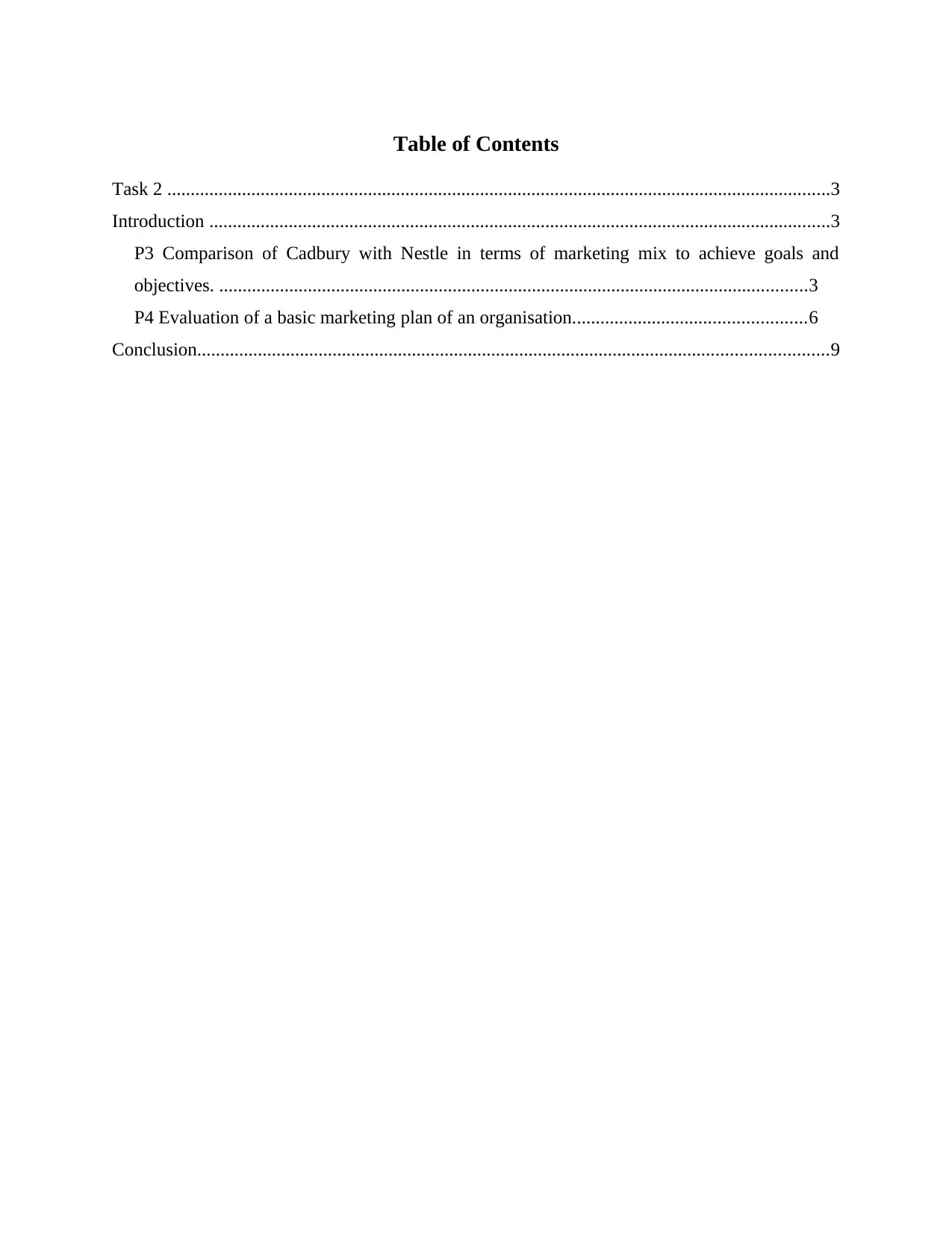
Table of Contents
Task 2 ..............................................................................................................................................3
Introduction .....................................................................................................................................3
P3 Comparison of Cadbury with Nestle in terms of marketing mix to achieve goals and
objectives. ..............................................................................................................................3
P4 Evaluation of a basic marketing plan of an organisation..................................................6
Conclusion.......................................................................................................................................9
Task 2 ..............................................................................................................................................3
Introduction .....................................................................................................................................3
P3 Comparison of Cadbury with Nestle in terms of marketing mix to achieve goals and
objectives. ..............................................................................................................................3
P4 Evaluation of a basic marketing plan of an organisation..................................................6
Conclusion.......................................................................................................................................9
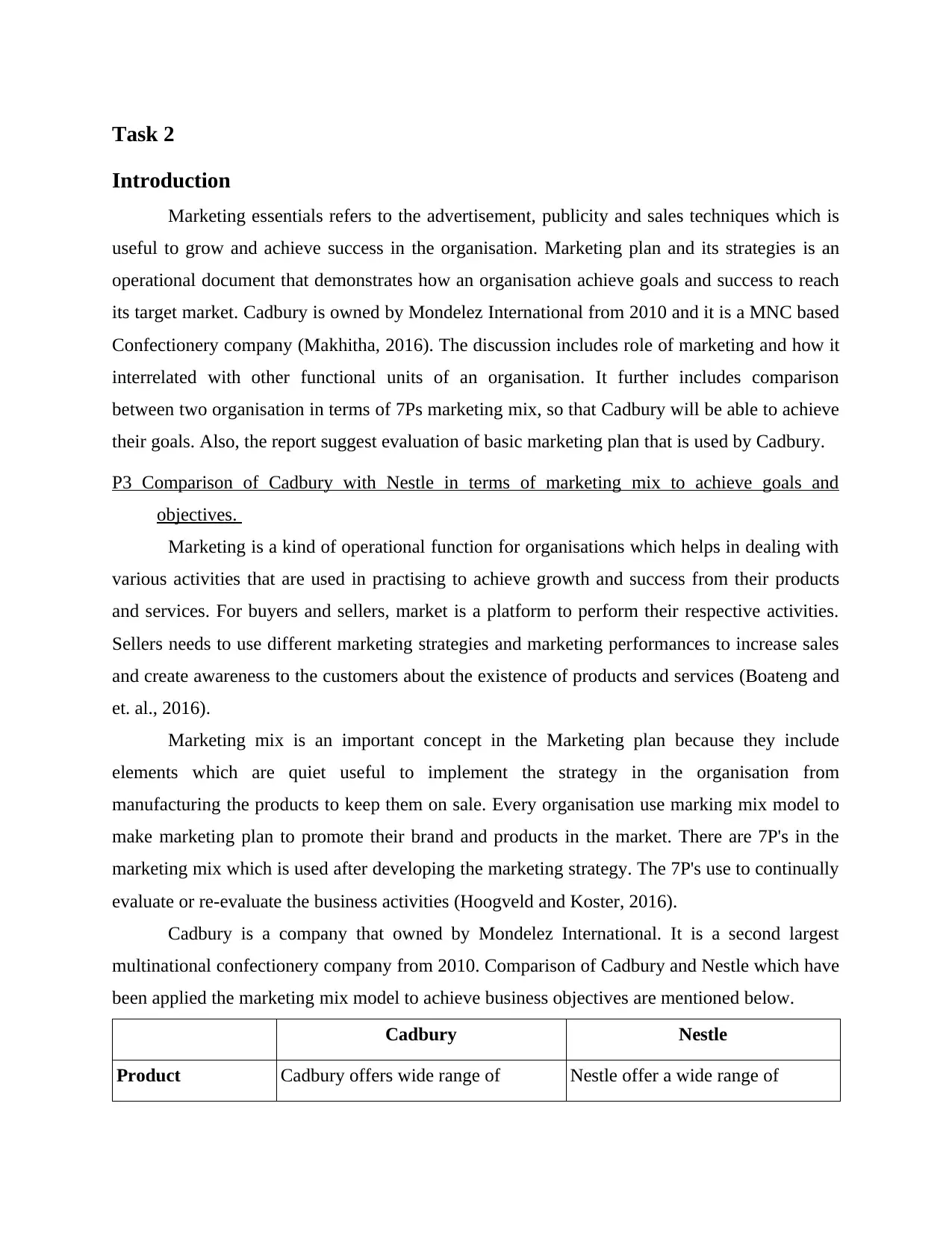
Task 2
Introduction
Marketing essentials refers to the advertisement, publicity and sales techniques which is
useful to grow and achieve success in the organisation. Marketing plan and its strategies is an
operational document that demonstrates how an organisation achieve goals and success to reach
its target market. Cadbury is owned by Mondelez International from 2010 and it is a MNC based
Confectionery company (Makhitha, 2016). The discussion includes role of marketing and how it
interrelated with other functional units of an organisation. It further includes comparison
between two organisation in terms of 7Ps marketing mix, so that Cadbury will be able to achieve
their goals. Also, the report suggest evaluation of basic marketing plan that is used by Cadbury.
P3 Comparison of Cadbury with Nestle in terms of marketing mix to achieve goals and
objectives.
Marketing is a kind of operational function for organisations which helps in dealing with
various activities that are used in practising to achieve growth and success from their products
and services. For buyers and sellers, market is a platform to perform their respective activities.
Sellers needs to use different marketing strategies and marketing performances to increase sales
and create awareness to the customers about the existence of products and services (Boateng and
et. al., 2016).
Marketing mix is an important concept in the Marketing plan because they include
elements which are quiet useful to implement the strategy in the organisation from
manufacturing the products to keep them on sale. Every organisation use marking mix model to
make marketing plan to promote their brand and products in the market. There are 7P's in the
marketing mix which is used after developing the marketing strategy. The 7P's use to continually
evaluate or re-evaluate the business activities (Hoogveld and Koster, 2016).
Cadbury is a company that owned by Mondelez International. It is a second largest
multinational confectionery company from 2010. Comparison of Cadbury and Nestle which have
been applied the marketing mix model to achieve business objectives are mentioned below.
Cadbury Nestle
Product Cadbury offers wide range of Nestle offer a wide range of
Introduction
Marketing essentials refers to the advertisement, publicity and sales techniques which is
useful to grow and achieve success in the organisation. Marketing plan and its strategies is an
operational document that demonstrates how an organisation achieve goals and success to reach
its target market. Cadbury is owned by Mondelez International from 2010 and it is a MNC based
Confectionery company (Makhitha, 2016). The discussion includes role of marketing and how it
interrelated with other functional units of an organisation. It further includes comparison
between two organisation in terms of 7Ps marketing mix, so that Cadbury will be able to achieve
their goals. Also, the report suggest evaluation of basic marketing plan that is used by Cadbury.
P3 Comparison of Cadbury with Nestle in terms of marketing mix to achieve goals and
objectives.
Marketing is a kind of operational function for organisations which helps in dealing with
various activities that are used in practising to achieve growth and success from their products
and services. For buyers and sellers, market is a platform to perform their respective activities.
Sellers needs to use different marketing strategies and marketing performances to increase sales
and create awareness to the customers about the existence of products and services (Boateng and
et. al., 2016).
Marketing mix is an important concept in the Marketing plan because they include
elements which are quiet useful to implement the strategy in the organisation from
manufacturing the products to keep them on sale. Every organisation use marking mix model to
make marketing plan to promote their brand and products in the market. There are 7P's in the
marketing mix which is used after developing the marketing strategy. The 7P's use to continually
evaluate or re-evaluate the business activities (Hoogveld and Koster, 2016).
Cadbury is a company that owned by Mondelez International. It is a second largest
multinational confectionery company from 2010. Comparison of Cadbury and Nestle which have
been applied the marketing mix model to achieve business objectives are mentioned below.
Cadbury Nestle
Product Cadbury offers wide range of Nestle offer a wide range of
You're viewing a preview
Unlock full access by subscribing today!
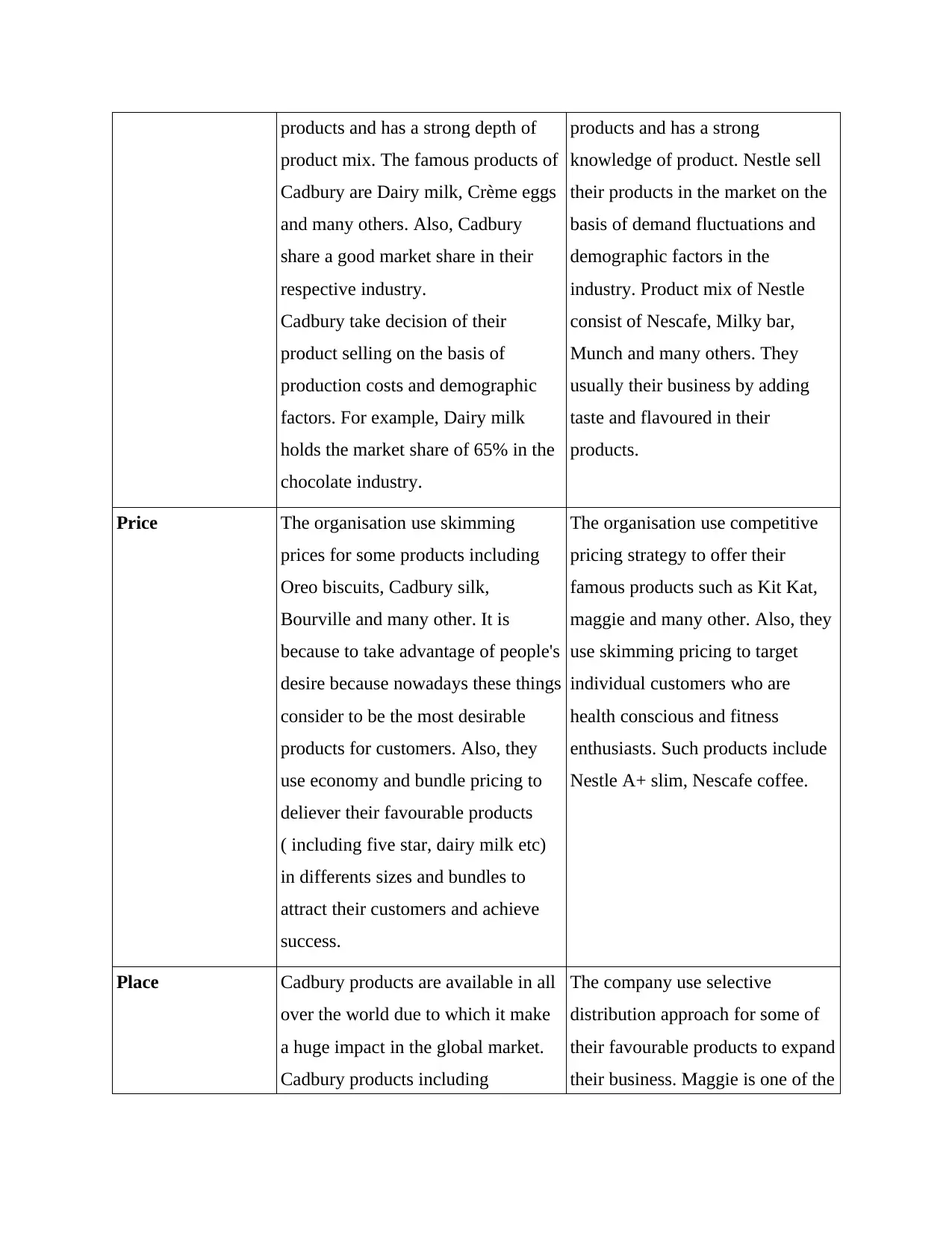
products and has a strong depth of
product mix. The famous products of
Cadbury are Dairy milk, Crème eggs
and many others. Also, Cadbury
share a good market share in their
respective industry.
Cadbury take decision of their
product selling on the basis of
production costs and demographic
factors. For example, Dairy milk
holds the market share of 65% in the
chocolate industry.
products and has a strong
knowledge of product. Nestle sell
their products in the market on the
basis of demand fluctuations and
demographic factors in the
industry. Product mix of Nestle
consist of Nescafe, Milky bar,
Munch and many others. They
usually their business by adding
taste and flavoured in their
products.
Price The organisation use skimming
prices for some products including
Oreo biscuits, Cadbury silk,
Bourville and many other. It is
because to take advantage of people's
desire because nowadays these things
consider to be the most desirable
products for customers. Also, they
use economy and bundle pricing to
deliever their favourable products
( including five star, dairy milk etc)
in differents sizes and bundles to
attract their customers and achieve
success.
The organisation use competitive
pricing strategy to offer their
famous products such as Kit Kat,
maggie and many other. Also, they
use skimming pricing to target
individual customers who are
health conscious and fitness
enthusiasts. Such products include
Nestle A+ slim, Nescafe coffee.
Place Cadbury products are available in all
over the world due to which it make
a huge impact in the global market.
Cadbury products including
The company use selective
distribution approach for some of
their favourable products to expand
their business. Maggie is one of the
product mix. The famous products of
Cadbury are Dairy milk, Crème eggs
and many others. Also, Cadbury
share a good market share in their
respective industry.
Cadbury take decision of their
product selling on the basis of
production costs and demographic
factors. For example, Dairy milk
holds the market share of 65% in the
chocolate industry.
products and has a strong
knowledge of product. Nestle sell
their products in the market on the
basis of demand fluctuations and
demographic factors in the
industry. Product mix of Nestle
consist of Nescafe, Milky bar,
Munch and many others. They
usually their business by adding
taste and flavoured in their
products.
Price The organisation use skimming
prices for some products including
Oreo biscuits, Cadbury silk,
Bourville and many other. It is
because to take advantage of people's
desire because nowadays these things
consider to be the most desirable
products for customers. Also, they
use economy and bundle pricing to
deliever their favourable products
( including five star, dairy milk etc)
in differents sizes and bundles to
attract their customers and achieve
success.
The organisation use competitive
pricing strategy to offer their
famous products such as Kit Kat,
maggie and many other. Also, they
use skimming pricing to target
individual customers who are
health conscious and fitness
enthusiasts. Such products include
Nestle A+ slim, Nescafe coffee.
Place Cadbury products are available in all
over the world due to which it make
a huge impact in the global market.
Cadbury products including
The company use selective
distribution approach for some of
their favourable products to expand
their business. Maggie is one of the
Paraphrase This Document
Need a fresh take? Get an instant paraphrase of this document with our AI Paraphraser
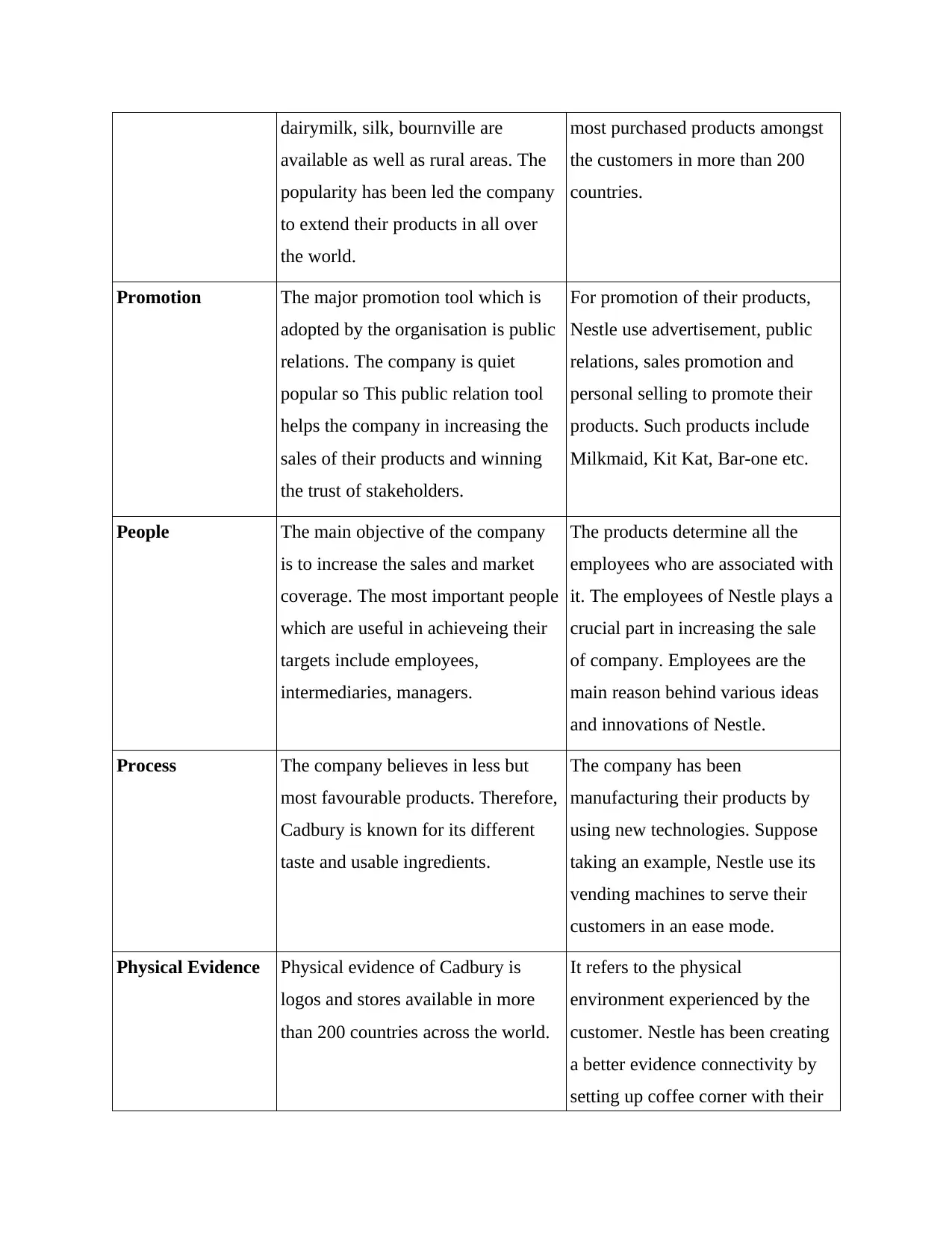
dairymilk, silk, bournville are
available as well as rural areas. The
popularity has been led the company
to extend their products in all over
the world.
most purchased products amongst
the customers in more than 200
countries.
Promotion The major promotion tool which is
adopted by the organisation is public
relations. The company is quiet
popular so This public relation tool
helps the company in increasing the
sales of their products and winning
the trust of stakeholders.
For promotion of their products,
Nestle use advertisement, public
relations, sales promotion and
personal selling to promote their
products. Such products include
Milkmaid, Kit Kat, Bar-one etc.
People The main objective of the company
is to increase the sales and market
coverage. The most important people
which are useful in achieveing their
targets include employees,
intermediaries, managers.
The products determine all the
employees who are associated with
it. The employees of Nestle plays a
crucial part in increasing the sale
of company. Employees are the
main reason behind various ideas
and innovations of Nestle.
Process The company believes in less but
most favourable products. Therefore,
Cadbury is known for its different
taste and usable ingredients.
The company has been
manufacturing their products by
using new technologies. Suppose
taking an example, Nestle use its
vending machines to serve their
customers in an ease mode.
Physical Evidence Physical evidence of Cadbury is
logos and stores available in more
than 200 countries across the world.
It refers to the physical
environment experienced by the
customer. Nestle has been creating
a better evidence connectivity by
setting up coffee corner with their
available as well as rural areas. The
popularity has been led the company
to extend their products in all over
the world.
most purchased products amongst
the customers in more than 200
countries.
Promotion The major promotion tool which is
adopted by the organisation is public
relations. The company is quiet
popular so This public relation tool
helps the company in increasing the
sales of their products and winning
the trust of stakeholders.
For promotion of their products,
Nestle use advertisement, public
relations, sales promotion and
personal selling to promote their
products. Such products include
Milkmaid, Kit Kat, Bar-one etc.
People The main objective of the company
is to increase the sales and market
coverage. The most important people
which are useful in achieveing their
targets include employees,
intermediaries, managers.
The products determine all the
employees who are associated with
it. The employees of Nestle plays a
crucial part in increasing the sale
of company. Employees are the
main reason behind various ideas
and innovations of Nestle.
Process The company believes in less but
most favourable products. Therefore,
Cadbury is known for its different
taste and usable ingredients.
The company has been
manufacturing their products by
using new technologies. Suppose
taking an example, Nestle use its
vending machines to serve their
customers in an ease mode.
Physical Evidence Physical evidence of Cadbury is
logos and stores available in more
than 200 countries across the world.
It refers to the physical
environment experienced by the
customer. Nestle has been creating
a better evidence connectivity by
setting up coffee corner with their

logos in a vending machines.
There is a need of right approach to be followed in the marketing plan. To prepare a
market plan there are steps to be taken into the consideration. It includes:1. Analysis: Marketers should analyse the proper conditions and possibilities first. Analysis
of business environment and current situation in the market is needed by Cadbury to
analysis and make and effective marketing plan (Russ-Mohl and Nazhdiminova, 2015).2. Planning: After analysing the marketing strategy, market needs to make a blue print to
implement all the actions and process. Planning involves various activities of Cadbury
done in the marketing plan.3. Implementation: Bringing the plan into action is an important thing which needs to be
taken into the consideration by all the marketers. Continuous flow of activities suggest
implementation of the marketing plan. It is a stage that deals which bringing the plan into
the actions. All the marketing tools need proper plan and processing.
4. Control: When the plan is executed, then there is a need to control the effective plan on
the basis of achieving growth. Control includes a regular check on the activities of the
marketing.
The above discussion concludes that Cadbury uses marketing plan with various strategies
including pricing, promotional and distributional. Pricing strategy helps the Cadbury
organisation to determine the particular criteria followed in calculating the price of product.
P4 Evaluation of a basic marketing plan of an organisation.
Executive summary: This report is focusing on the marketing environment of the company
known as, Cadbury. Cadbury is a company which is owned by Modelez International in 2010
and it is a second largest confectionery company of United Kingdom. British multinational
confectionery company owned by Mondelez International. Segmentation, Target and Positioning
(STP) model have been used by Cadbury to understand their target positioning in the market.
Financial performance, product portfolio and value chain analysis have been used. Also, SWOT
analysis model is mentioned below to identify the strengths, weaknesses, opportunities and
threats of Cadbury organisation. Various recommendations have been also used to increase their
communication between areas and brand recognition.
There is a need of right approach to be followed in the marketing plan. To prepare a
market plan there are steps to be taken into the consideration. It includes:1. Analysis: Marketers should analyse the proper conditions and possibilities first. Analysis
of business environment and current situation in the market is needed by Cadbury to
analysis and make and effective marketing plan (Russ-Mohl and Nazhdiminova, 2015).2. Planning: After analysing the marketing strategy, market needs to make a blue print to
implement all the actions and process. Planning involves various activities of Cadbury
done in the marketing plan.3. Implementation: Bringing the plan into action is an important thing which needs to be
taken into the consideration by all the marketers. Continuous flow of activities suggest
implementation of the marketing plan. It is a stage that deals which bringing the plan into
the actions. All the marketing tools need proper plan and processing.
4. Control: When the plan is executed, then there is a need to control the effective plan on
the basis of achieving growth. Control includes a regular check on the activities of the
marketing.
The above discussion concludes that Cadbury uses marketing plan with various strategies
including pricing, promotional and distributional. Pricing strategy helps the Cadbury
organisation to determine the particular criteria followed in calculating the price of product.
P4 Evaluation of a basic marketing plan of an organisation.
Executive summary: This report is focusing on the marketing environment of the company
known as, Cadbury. Cadbury is a company which is owned by Modelez International in 2010
and it is a second largest confectionery company of United Kingdom. British multinational
confectionery company owned by Mondelez International. Segmentation, Target and Positioning
(STP) model have been used by Cadbury to understand their target positioning in the market.
Financial performance, product portfolio and value chain analysis have been used. Also, SWOT
analysis model is mentioned below to identify the strengths, weaknesses, opportunities and
threats of Cadbury organisation. Various recommendations have been also used to increase their
communication between areas and brand recognition.
You're viewing a preview
Unlock full access by subscribing today!
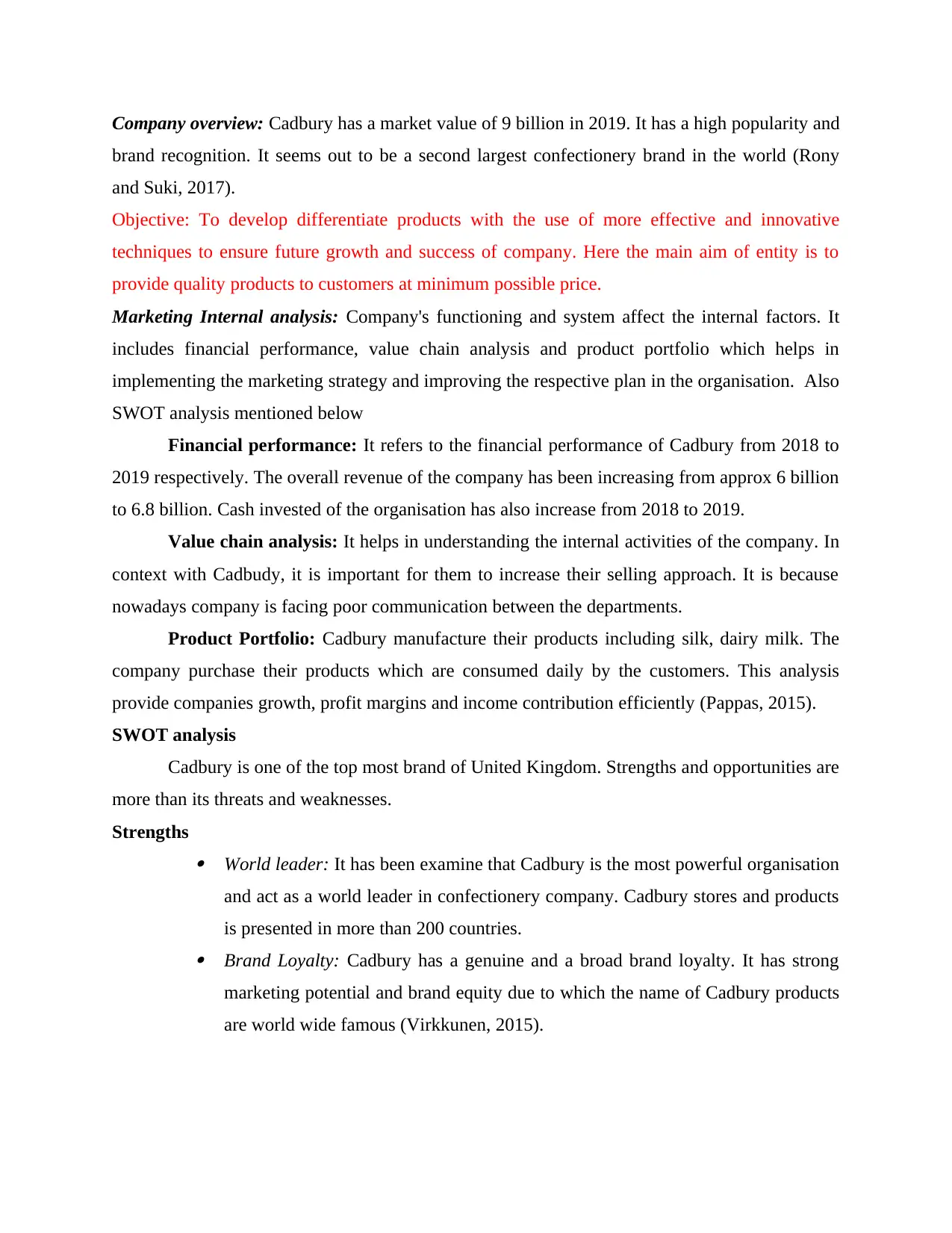
Company overview: Cadbury has a market value of 9 billion in 2019. It has a high popularity and
brand recognition. It seems out to be a second largest confectionery brand in the world (Rony
and Suki, 2017).
Objective: To develop differentiate products with the use of more effective and innovative
techniques to ensure future growth and success of company. Here the main aim of entity is to
provide quality products to customers at minimum possible price.
Marketing Internal analysis: Company's functioning and system affect the internal factors. It
includes financial performance, value chain analysis and product portfolio which helps in
implementing the marketing strategy and improving the respective plan in the organisation. Also
SWOT analysis mentioned below
Financial performance: It refers to the financial performance of Cadbury from 2018 to
2019 respectively. The overall revenue of the company has been increasing from approx 6 billion
to 6.8 billion. Cash invested of the organisation has also increase from 2018 to 2019.
Value chain analysis: It helps in understanding the internal activities of the company. In
context with Cadbudy, it is important for them to increase their selling approach. It is because
nowadays company is facing poor communication between the departments.
Product Portfolio: Cadbury manufacture their products including silk, dairy milk. The
company purchase their products which are consumed daily by the customers. This analysis
provide companies growth, profit margins and income contribution efficiently (Pappas, 2015).
SWOT analysis
Cadbury is one of the top most brand of United Kingdom. Strengths and opportunities are
more than its threats and weaknesses.
Strengths
World leader: It has been examine that Cadbury is the most powerful organisation
and act as a world leader in confectionery company. Cadbury stores and products
is presented in more than 200 countries.
Brand Loyalty: Cadbury has a genuine and a broad brand loyalty. It has strong
marketing potential and brand equity due to which the name of Cadbury products
are world wide famous (Virkkunen, 2015).
brand recognition. It seems out to be a second largest confectionery brand in the world (Rony
and Suki, 2017).
Objective: To develop differentiate products with the use of more effective and innovative
techniques to ensure future growth and success of company. Here the main aim of entity is to
provide quality products to customers at minimum possible price.
Marketing Internal analysis: Company's functioning and system affect the internal factors. It
includes financial performance, value chain analysis and product portfolio which helps in
implementing the marketing strategy and improving the respective plan in the organisation. Also
SWOT analysis mentioned below
Financial performance: It refers to the financial performance of Cadbury from 2018 to
2019 respectively. The overall revenue of the company has been increasing from approx 6 billion
to 6.8 billion. Cash invested of the organisation has also increase from 2018 to 2019.
Value chain analysis: It helps in understanding the internal activities of the company. In
context with Cadbudy, it is important for them to increase their selling approach. It is because
nowadays company is facing poor communication between the departments.
Product Portfolio: Cadbury manufacture their products including silk, dairy milk. The
company purchase their products which are consumed daily by the customers. This analysis
provide companies growth, profit margins and income contribution efficiently (Pappas, 2015).
SWOT analysis
Cadbury is one of the top most brand of United Kingdom. Strengths and opportunities are
more than its threats and weaknesses.
Strengths
World leader: It has been examine that Cadbury is the most powerful organisation
and act as a world leader in confectionery company. Cadbury stores and products
is presented in more than 200 countries.
Brand Loyalty: Cadbury has a genuine and a broad brand loyalty. It has strong
marketing potential and brand equity due to which the name of Cadbury products
are world wide famous (Virkkunen, 2015).
Paraphrase This Document
Need a fresh take? Get an instant paraphrase of this document with our AI Paraphraser
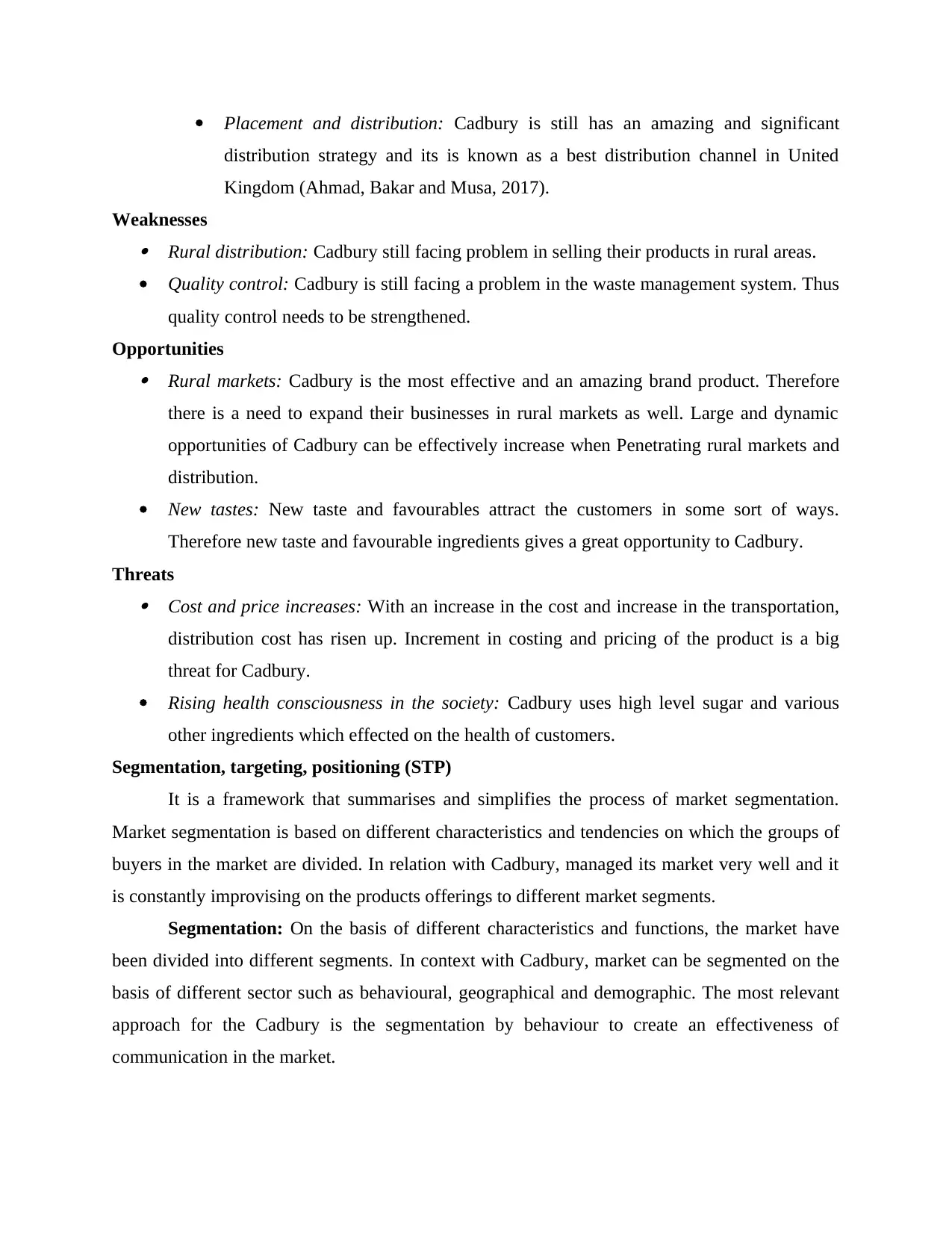
Placement and distribution: Cadbury is still has an amazing and significant
distribution strategy and its is known as a best distribution channel in United
Kingdom (Ahmad, Bakar and Musa, 2017).
Weaknesses Rural distribution: Cadbury still facing problem in selling their products in rural areas.
Quality control: Cadbury is still facing a problem in the waste management system. Thus
quality control needs to be strengthened.
Opportunities Rural markets: Cadbury is the most effective and an amazing brand product. Therefore
there is a need to expand their businesses in rural markets as well. Large and dynamic
opportunities of Cadbury can be effectively increase when Penetrating rural markets and
distribution.
New tastes: New taste and favourables attract the customers in some sort of ways.
Therefore new taste and favourable ingredients gives a great opportunity to Cadbury.
Threats Cost and price increases: With an increase in the cost and increase in the transportation,
distribution cost has risen up. Increment in costing and pricing of the product is a big
threat for Cadbury.
Rising health consciousness in the society: Cadbury uses high level sugar and various
other ingredients which effected on the health of customers.
Segmentation, targeting, positioning (STP)
It is a framework that summarises and simplifies the process of market segmentation.
Market segmentation is based on different characteristics and tendencies on which the groups of
buyers in the market are divided. In relation with Cadbury, managed its market very well and it
is constantly improvising on the products offerings to different market segments.
Segmentation: On the basis of different characteristics and functions, the market have
been divided into different segments. In context with Cadbury, market can be segmented on the
basis of different sector such as behavioural, geographical and demographic. The most relevant
approach for the Cadbury is the segmentation by behaviour to create an effectiveness of
communication in the market.
distribution strategy and its is known as a best distribution channel in United
Kingdom (Ahmad, Bakar and Musa, 2017).
Weaknesses Rural distribution: Cadbury still facing problem in selling their products in rural areas.
Quality control: Cadbury is still facing a problem in the waste management system. Thus
quality control needs to be strengthened.
Opportunities Rural markets: Cadbury is the most effective and an amazing brand product. Therefore
there is a need to expand their businesses in rural markets as well. Large and dynamic
opportunities of Cadbury can be effectively increase when Penetrating rural markets and
distribution.
New tastes: New taste and favourables attract the customers in some sort of ways.
Therefore new taste and favourable ingredients gives a great opportunity to Cadbury.
Threats Cost and price increases: With an increase in the cost and increase in the transportation,
distribution cost has risen up. Increment in costing and pricing of the product is a big
threat for Cadbury.
Rising health consciousness in the society: Cadbury uses high level sugar and various
other ingredients which effected on the health of customers.
Segmentation, targeting, positioning (STP)
It is a framework that summarises and simplifies the process of market segmentation.
Market segmentation is based on different characteristics and tendencies on which the groups of
buyers in the market are divided. In relation with Cadbury, managed its market very well and it
is constantly improvising on the products offerings to different market segments.
Segmentation: On the basis of different characteristics and functions, the market have
been divided into different segments. In context with Cadbury, market can be segmented on the
basis of different sector such as behavioural, geographical and demographic. The most relevant
approach for the Cadbury is the segmentation by behaviour to create an effectiveness of
communication in the market.
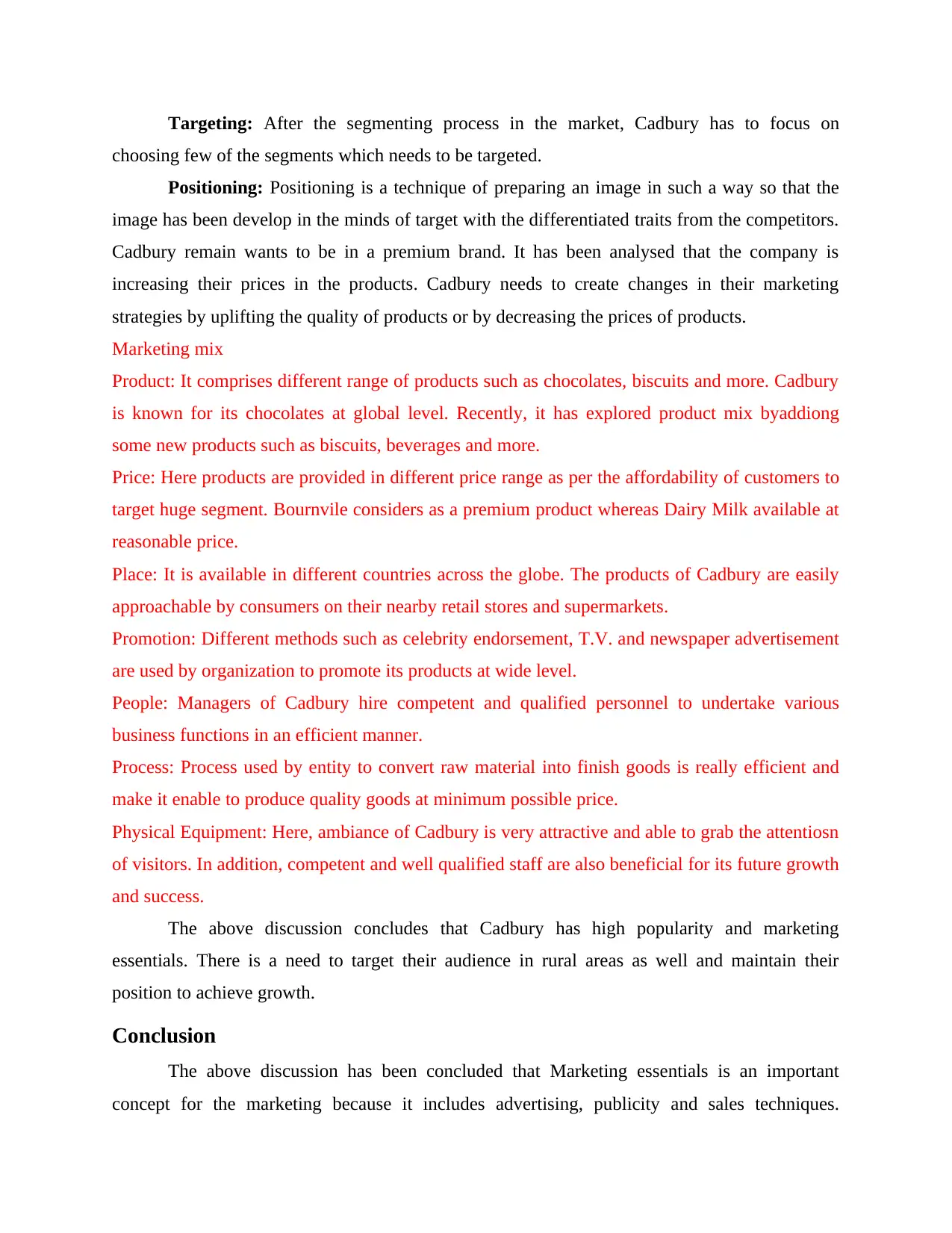
Targeting: After the segmenting process in the market, Cadbury has to focus on
choosing few of the segments which needs to be targeted.
Positioning: Positioning is a technique of preparing an image in such a way so that the
image has been develop in the minds of target with the differentiated traits from the competitors.
Cadbury remain wants to be in a premium brand. It has been analysed that the company is
increasing their prices in the products. Cadbury needs to create changes in their marketing
strategies by uplifting the quality of products or by decreasing the prices of products.
Marketing mix
Product: It comprises different range of products such as chocolates, biscuits and more. Cadbury
is known for its chocolates at global level. Recently, it has explored product mix byaddiong
some new products such as biscuits, beverages and more.
Price: Here products are provided in different price range as per the affordability of customers to
target huge segment. Bournvile considers as a premium product whereas Dairy Milk available at
reasonable price.
Place: It is available in different countries across the globe. The products of Cadbury are easily
approachable by consumers on their nearby retail stores and supermarkets.
Promotion: Different methods such as celebrity endorsement, T.V. and newspaper advertisement
are used by organization to promote its products at wide level.
People: Managers of Cadbury hire competent and qualified personnel to undertake various
business functions in an efficient manner.
Process: Process used by entity to convert raw material into finish goods is really efficient and
make it enable to produce quality goods at minimum possible price.
Physical Equipment: Here, ambiance of Cadbury is very attractive and able to grab the attentiosn
of visitors. In addition, competent and well qualified staff are also beneficial for its future growth
and success.
The above discussion concludes that Cadbury has high popularity and marketing
essentials. There is a need to target their audience in rural areas as well and maintain their
position to achieve growth.
Conclusion
The above discussion has been concluded that Marketing essentials is an important
concept for the marketing because it includes advertising, publicity and sales techniques.
choosing few of the segments which needs to be targeted.
Positioning: Positioning is a technique of preparing an image in such a way so that the
image has been develop in the minds of target with the differentiated traits from the competitors.
Cadbury remain wants to be in a premium brand. It has been analysed that the company is
increasing their prices in the products. Cadbury needs to create changes in their marketing
strategies by uplifting the quality of products or by decreasing the prices of products.
Marketing mix
Product: It comprises different range of products such as chocolates, biscuits and more. Cadbury
is known for its chocolates at global level. Recently, it has explored product mix byaddiong
some new products such as biscuits, beverages and more.
Price: Here products are provided in different price range as per the affordability of customers to
target huge segment. Bournvile considers as a premium product whereas Dairy Milk available at
reasonable price.
Place: It is available in different countries across the globe. The products of Cadbury are easily
approachable by consumers on their nearby retail stores and supermarkets.
Promotion: Different methods such as celebrity endorsement, T.V. and newspaper advertisement
are used by organization to promote its products at wide level.
People: Managers of Cadbury hire competent and qualified personnel to undertake various
business functions in an efficient manner.
Process: Process used by entity to convert raw material into finish goods is really efficient and
make it enable to produce quality goods at minimum possible price.
Physical Equipment: Here, ambiance of Cadbury is very attractive and able to grab the attentiosn
of visitors. In addition, competent and well qualified staff are also beneficial for its future growth
and success.
The above discussion concludes that Cadbury has high popularity and marketing
essentials. There is a need to target their audience in rural areas as well and maintain their
position to achieve growth.
Conclusion
The above discussion has been concluded that Marketing essentials is an important
concept for the marketing because it includes advertising, publicity and sales techniques.
You're viewing a preview
Unlock full access by subscribing today!

Cadbury is the second largest UK based multinational confectioneries. Discussion has been
carried about the role of marketing and its interrelation with the functional units of an
organisation. In addition to this, comparison of Cadbury with Nestle on the basis of their
respective marketing mix model which helps to develop the marketing strategy. This report also
suggest evaluation of a basic marketing plan that is used by Cadbury.
carried about the role of marketing and its interrelation with the functional units of an
organisation. In addition to this, comparison of Cadbury with Nestle on the basis of their
respective marketing mix model which helps to develop the marketing strategy. This report also
suggest evaluation of a basic marketing plan that is used by Cadbury.
Paraphrase This Document
Need a fresh take? Get an instant paraphrase of this document with our AI Paraphraser
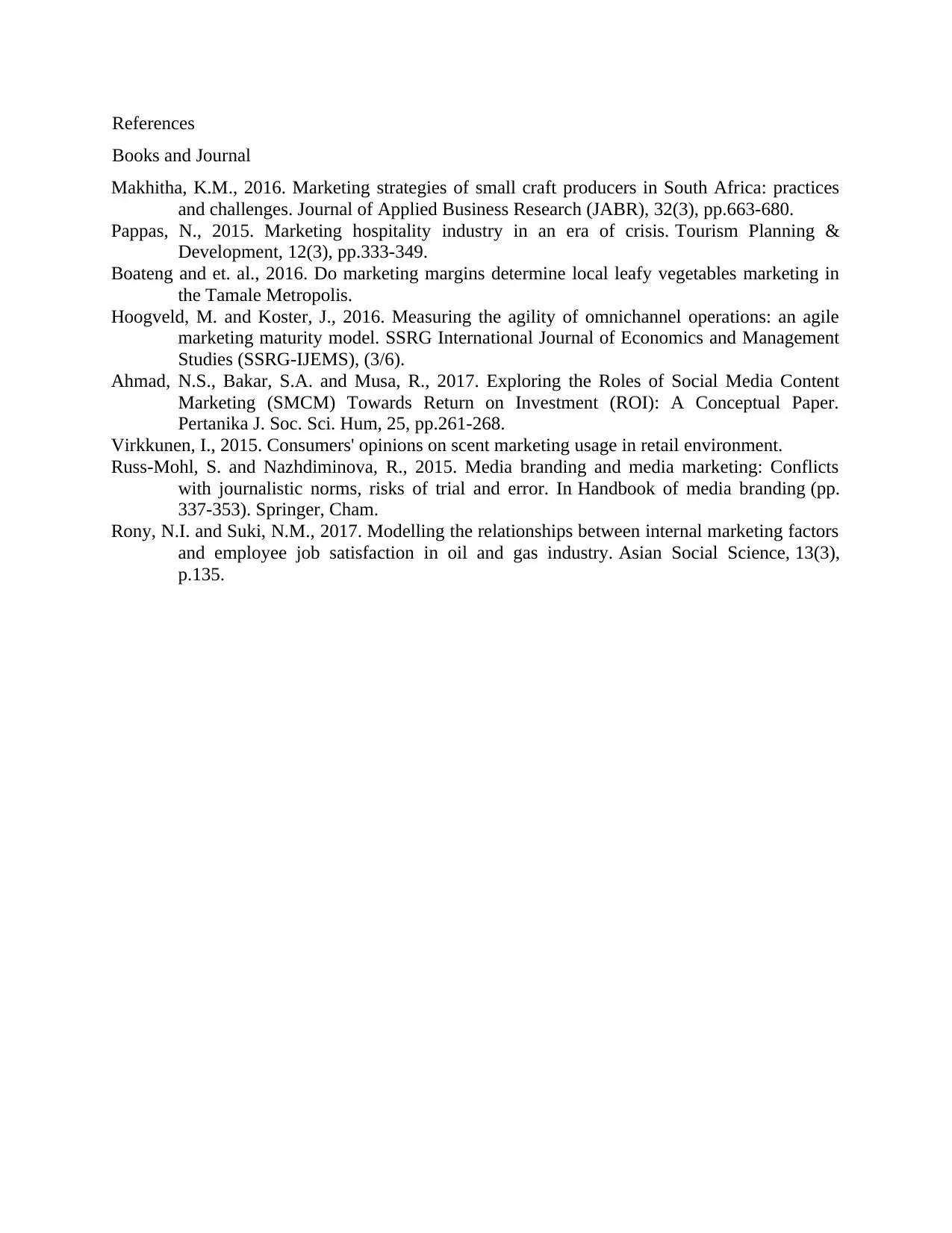
References
Books and Journal
Makhitha, K.M., 2016. Marketing strategies of small craft producers in South Africa: practices
and challenges. Journal of Applied Business Research (JABR), 32(3), pp.663-680.
Pappas, N., 2015. Marketing hospitality industry in an era of crisis. Tourism Planning &
Development, 12(3), pp.333-349.
Boateng and et. al., 2016. Do marketing margins determine local leafy vegetables marketing in
the Tamale Metropolis.
Hoogveld, M. and Koster, J., 2016. Measuring the agility of omnichannel operations: an agile
marketing maturity model. SSRG International Journal of Economics and Management
Studies (SSRG-IJEMS), (3/6).
Ahmad, N.S., Bakar, S.A. and Musa, R., 2017. Exploring the Roles of Social Media Content
Marketing (SMCM) Towards Return on Investment (ROI): A Conceptual Paper.
Pertanika J. Soc. Sci. Hum, 25, pp.261-268.
Virkkunen, I., 2015. Consumers' opinions on scent marketing usage in retail environment.
Russ-Mohl, S. and Nazhdiminova, R., 2015. Media branding and media marketing: Conflicts
with journalistic norms, risks of trial and error. In Handbook of media branding (pp.
337-353). Springer, Cham.
Rony, N.I. and Suki, N.M., 2017. Modelling the relationships between internal marketing factors
and employee job satisfaction in oil and gas industry. Asian Social Science, 13(3),
p.135.
Books and Journal
Makhitha, K.M., 2016. Marketing strategies of small craft producers in South Africa: practices
and challenges. Journal of Applied Business Research (JABR), 32(3), pp.663-680.
Pappas, N., 2015. Marketing hospitality industry in an era of crisis. Tourism Planning &
Development, 12(3), pp.333-349.
Boateng and et. al., 2016. Do marketing margins determine local leafy vegetables marketing in
the Tamale Metropolis.
Hoogveld, M. and Koster, J., 2016. Measuring the agility of omnichannel operations: an agile
marketing maturity model. SSRG International Journal of Economics and Management
Studies (SSRG-IJEMS), (3/6).
Ahmad, N.S., Bakar, S.A. and Musa, R., 2017. Exploring the Roles of Social Media Content
Marketing (SMCM) Towards Return on Investment (ROI): A Conceptual Paper.
Pertanika J. Soc. Sci. Hum, 25, pp.261-268.
Virkkunen, I., 2015. Consumers' opinions on scent marketing usage in retail environment.
Russ-Mohl, S. and Nazhdiminova, R., 2015. Media branding and media marketing: Conflicts
with journalistic norms, risks of trial and error. In Handbook of media branding (pp.
337-353). Springer, Cham.
Rony, N.I. and Suki, N.M., 2017. Modelling the relationships between internal marketing factors
and employee job satisfaction in oil and gas industry. Asian Social Science, 13(3),
p.135.
1 out of 11
Related Documents
Your All-in-One AI-Powered Toolkit for Academic Success.
+13062052269
info@desklib.com
Available 24*7 on WhatsApp / Email
![[object Object]](/_next/static/media/star-bottom.7253800d.svg)
Unlock your academic potential
© 2024 | Zucol Services PVT LTD | All rights reserved.





